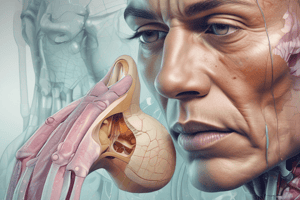Podcast
Questions and Answers
Where is the frontal sinus located?
Where is the frontal sinus located?
- In the sides of the nose
- In the forehead (correct)
- Behind the nasal bone
- Behind the ethmoid
Which sinus is located behind the nasal bone?
Which sinus is located behind the nasal bone?
- Maxillary
- Sphenoid
- Frontal
- Ethmoid (correct)
What is the largest sinus and the most likely to get infected?
What is the largest sinus and the most likely to get infected?
- Frontal
- Ethmoid
- Maxillary (correct)
- Sphenoid
Where is the sphenoid sinus located?
Where is the sphenoid sinus located?
Which of the following is NOT a location of a paranasal sinus?
Which of the following is NOT a location of a paranasal sinus?
What percentage of the epithelial cells in the trachea are basal cells?
What percentage of the epithelial cells in the trachea are basal cells?
What is the function of the afferent nerve endings on the basal surface of brush cells?
What is the function of the afferent nerve endings on the basal surface of brush cells?
What is the characteristic feature of the apical surface of brush cells?
What is the characteristic feature of the apical surface of brush cells?
What is the percentage of brush cells in the trachea?
What is the percentage of brush cells in the trachea?
What is the function of brush cells in the trachea?
What is the function of brush cells in the trachea?
What type of neurons are olfactory cells?
What type of neurons are olfactory cells?
Where are the nuclei of olfactory cells located in relation to the nuclei of supporting cells?
Where are the nuclei of olfactory cells located in relation to the nuclei of supporting cells?
What is the function of supporting cells in the olfactory system?
What is the function of supporting cells in the olfactory system?
What is the relationship between basal cells and olfactory cells?
What is the relationship between basal cells and olfactory cells?
What is the arrangement of the nuclei of olfactory cells and supporting cells?
What is the arrangement of the nuclei of olfactory cells and supporting cells?
Which sinus is not part of the paranasal sinuses listed?
Which sinus is not part of the paranasal sinuses listed?
What is the function of the Nasopharynx?
What is the function of the Nasopharynx?
How many parts does the Pharynx have?
How many parts does the Pharynx have?
What type of epithelium lines the Nasopharynx?
What type of epithelium lines the Nasopharynx?
What is the first part of the Pharynx?
What is the first part of the Pharynx?
What is the main difference between the mucosa of the primary bronchus and the tracheal mucosa?
What is the main difference between the mucosa of the primary bronchus and the tracheal mucosa?
What happens to the cartilage in smaller bronchi?
What happens to the cartilage in smaller bronchi?
What happens to the smooth muscle in smaller bronchioles?
What happens to the smooth muscle in smaller bronchioles?
What is characteristic of the epithelium in larger bronchioles?
What is characteristic of the epithelium in larger bronchioles?
What is the last part of the air conducting system?
What is the last part of the air conducting system?
What is lacking in bronchioles?
What is lacking in bronchioles?
Flashcards are hidden until you start studying
Study Notes
Olfactory Epithelium
- Basal cells make up 30% of the epithelium
- Brush cells with microvilli on apical surface and afferent nerve endings on basal surface act as chemosensory receptors, making up 3% of the epithelium
- Olfactory cells are bipolar neurons with nuclei located below the nuclei of supporting cells, with a small opening to the nasal cavity
Para-Nasal Sinuses
- Frontal sinus located in the forehead
- Ethmoid sinus located behind the nasal bone
- Sphenoid sinus located behind the ethmoid bone
- Maxillary sinus located on the sides of the nose
- The maxillary sinus is the largest and most likely to get infected
Nasopharynx
- First part of the pharynx
- Lined with respiratory epithelium
Pharynx
- Divided into three regions
- Terminal bronchiole is the last part of the air conducting system
Primary Bronchus
- Mucosa is structurally similar to tracheal mucosa except for the organization of cartilage and smooth muscle
- Cartilage rings completely encircle the lumen
Secondary and Smaller Bronchus
- Cartilage is reduced to many pieces of hyaline cartilage
- Smooth muscle, elastic fibers, and mucosa-associated lymphoid tissue (MALT) become relatively more abundant as bronchi become smaller
- Mucosa are folded due to contraction of smooth muscle
Bronchioles
- Lack mucosal glands
- Lack cartilage
- Goblet cells are reduced
- Muscle becomes relatively more abundant
- Epithelium in larger bronchioles is ciliated pseudostratified columnar, decreasing in height to become ciliated simple columnar in smaller bronchioles
Studying That Suits You
Use AI to generate personalized quizzes and flashcards to suit your learning preferences.




